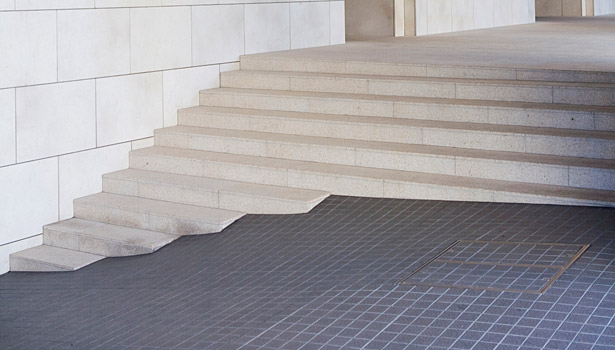Ensuring Floor Covering Sustainability
“Green” floor coverings are only as environmentally friendly as the adhesives and other materials used in their installation.




Floor covering manufacturers have made considerable progress in developing coverings, both hard and soft, that are healthier for building users because they have less impact on the environment. However, just because a floor covering is considered “green” or more environmentally preferable does not mean it will continue to have less impact on the environment and the health of building users once installed.
This was brought to light several years ago through research conducted by Greg Norris, Ph.D., of the Harvard School of Public Health. Norris studied a variety of hard surface flooring materials and concluded that because of some of the chemical ingredients found in conventional, non-green floor care products that were used to clean and maintain the floors, “the amount of volatile organic compounds (VOCs) emitted from a single waxing is comparable to the amount of VOCs emitted from [a green] floor over its entire lifetime.”
Essentially, Norris concluded that green components are only as strong as their weakest link. Taking the time, trouble, and possible added expense to select an environmentally preferable floor can be a waste if the floor is not maintained in an environmentally responsible manner.
Norris’ conclusion can also be applied to the installation of green flooring materials, such as ceramic tile, which are considered one of the more environmentally friendly floor coverings. If the tile coming from the manufacturer has been specifically developed to reduce the impact of building materials on the environment, but is installed using adhesives made with urethane or other materials that can potentially harm the environment, the environmentally preferable benefits of the tile may be lost.
Making a Floor Covering Green
First, it is necessary to understand what makes a floor covering environmentally preferable. A green building product is one that, among other things, is designed to have a reduced impact on people and the environment. When analyzing floor coverings, some of the key green attributes to look for include the following:
• The materials used to make the flooring break down relatively quickly when deposited in landfills
• The flooring releases few (if any) VOCs, and any off-gassing is short-lived
• The flooring does not contain toxic materials, and manufacturing methods are not detrimental to the environment
• The flooring is made from renewable and recycled materials, and materials that are easily recycled
Ceramic tile is often a good example of these key attributes. In fact, tile is frequently referred to as “clean fill” because, even when buried in a landfill, it typically has little impact on the environment. This may be because ceramic materials are composed mainly of natural materials, such as clay and shale.
As most manufacturers and consumers know, ceramic tile is also a durable building product. According to one study, stone and ceramic tile have been in place in some structures for hundreds, if not thousands, of years. In addition, ceramic tile emits few VOCs, which can cause a variety of respiratory or allergic reactions.1
Along with VOCs, ingredients found in some building materials that are not found in greener floor coverings include formaldehyde and ozone-depleting substances, which cause the deterioration of the earth’s protective ozone layer. In significant amounts for long durations, exposure to these ingredients can cause respiratory problems, especially for children and older adults, according to studies comparing different floor and wall coverings by the California Department of Health Services.
The Green Installation Component
Adhesives serve many purposes in floor covering installations. Their main job is simply to help secure the floor covering in place. When it comes to hard surface coverings, some adhesives are designed to be used in wet areas, such as showers, while others are made for dry areas, such as entryways and common area walkways. In addition, some adhesives are designed to allow floors to expand or contract over time while keeping the covering secured to the floor or wall.
“When used to install an environmentally preferable floor covering, the potential harmful impact of a conventional, non-green adhesive may outweigh the green attributes of the tile,” said Linda Chipperfield, vice president of Marketing and Communications at Green Seal, a not-for-profit green certification organization that has developed a standard called “Adhesives for Commercial Use” (GS-36). The standard covers adhesives used for a variety of tasks, including the installation of many types of floor and wall covering. GS-36 is a multi-attribute standard based on the lifecycle impacts of adhesives. Among other guidelines, this standard establishes the following:
• Environmental requirements for adhesives intended and labeled for commercial use
• Product performance requirements
• Environmental and health requirements, such as reduced toxicity, hazardous ingredients, and VOCs
• Criteria that define for manufacturers which processes and ingredients are necessary for a product to be green and sustainable
While the standard is specifically designed to address the ingredients that are and are not allowed in adhesives, it also applies to how products are packaged—packaging must be reusable, recyclable, or re-conditionable—and even establishes measures to minimize or eliminate animal testing of ingredients that may be used in adhesives. (In place of animal testing, GS-36 allows for non-animal [in vitro] test results, modeling data, data from structural analogs and other lines of evidence, provided the methods are peer reviewed and applicable.)
Green from the Floor Up
While it has had its ups and downs, the green and sustainable movement is in full swing in North America and many other parts of the world. Along with the health and environmental benefits, the fact that some green and sustainable products and strategies have helped organizations reduce costs cannot be denied.
In light of this, it becomes clear why ceramic tile and certain other green floor coverings are likely to have a promising future. When the benefits are added up—long service lifecycle, little or no negative contribution to indoor air quality, minimal environmental impacts and ease of maintenance—it is evident that ceramic tile will move up the scale as a green building material for homes and commercial facilities. However, the materials used to install these tiles, as well as other floor and wall coverings, must move in the same direction and be green as well. Only then are they the right materials for today’s green building environment.
For additional information, visit www.greenseal.org.
Reference
1. Elliott, Lindsay, Award: The Magazine of Sustainable Architecture, Construction, and Interior Design, April 2001.
Looking for a reprint of this article?
From high-res PDFs to custom plaques, order your copy today!







